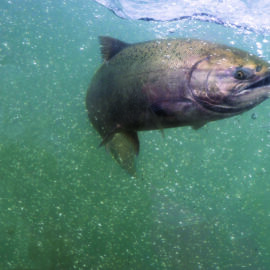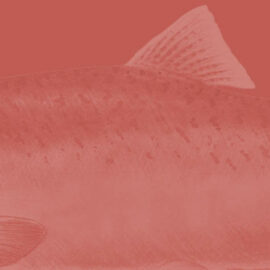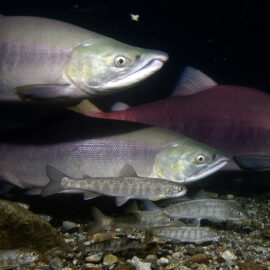Of all ocean-going Pacific salmon, spring Chinook are the first to return to freshwater each year. They arrive in their home rivers as early as March, holding enough energy reserves in their flesh to allow them to fast for months before spawning.
This remarkable behavior stems from spring Chinook’s unique genetic coding, which has survived for millions of years despite ice ages and floods, competition and predation. By hopscotching up river systems still swollen by meltwater and rain, spring Chinook travel into a watershed’s highest reaches.
These early returners are the beating heart of complex food webs that sustain species like the Salish Sea’s resident orcas and center salmon communities like the Yurok and Karuk people of Northern California. In the Pacific Northwest, spring Chinook transcend the iconic. They are our identity. And after 150 years of increasing, unprecedented threats, they are on the brink of extinction.
How we got here is a complicated story, full of dramatic roadblocks and scientific discoveries, hard realizations and reasons to hope. That’s the story we explore below in First Salmon, Last Chance—our four-part investigation into why spring Chinook are king, and what it will take to save them, before it’s too late. Download the First Salmon, Last Chance full series printable file.
FIRST SALMON, LAST CHANCE
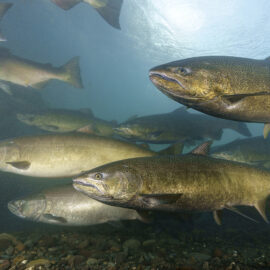
9 a.m. on a storm-threatening morning in late July. Amy Fingerle stands knee-deep in the upper Salmon River, a tributary of northern California’s remote Klamath River. She’s heard people say that spring Chinook here once outnumbered all other salmon, but that’s hard to prove without official records. None really existed until at least the 1960s—and none good until the 1990s, when the Salmon River Restoration Council began coordinating its annual fish dives.
Fingerle would know; for several years she helped run the dives. Now a doctoral student at UC-Berkeley, she’s returned for the 2020 counts as a volunteer. Today she’ll walk, swim, and stumble her way five miles down this canyon-walled river stretch, surveying for returning spring Chinook. What she finds will break her heart—and steel her resolve to give the first salmon a fighting chance.

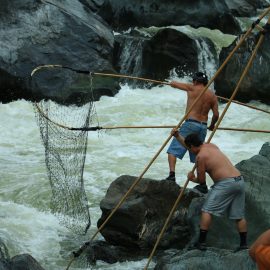
For the Karuk, Yurok, and Hoopa people of Northern California’s Klamath and Trinity rivers, each year starts with the arrival of spring-run Chinook, the first salmon, prized above all.
But for more than 150 years, key decisions impacting Klamath salmon runs—from destructive western mining and land use practices to the construction of massive dams—have been made by far-away state, federal, and private interests, largely without input from the Tribes, who successfully managed sustainable salmon runs for millennia prior to Western contact.
Now, with the Klamath’s spring Chinook runs in a tailspin, Indigenous communities are leading a game-changing national campaign to empower Indigenous knowledge in salmon management and tear down four Klamath River dams.

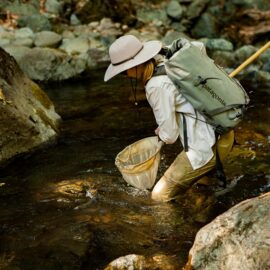
THE KEY IN THE CODE – PART III
Genetic science has come a long way since the mid-2000s. That was back when Dr. Michael Miller was still a doctoral candidate at the University of Oregon—before he’d earned his scholarly honorifics.
“A genome is like a big instruction manual that tells you how to make an organism,” explains Dr. Miller, now a a genetics professor at UC-Davis. “At the time, we didn’t have a fully decoded sequence. We didn’t have the full book. Imagine that you have only certain sentences, and you don’t know their order.”
As geneticists cracked open those first sentences, Dr. Miller hoped these new insights could help protect threatened species like the springers he hooked as a kid on Oregon’s Molalla River. What he didn’t expect was that his own research would rock the science on what it takes to be a spring Chinook, and ratchet up the pressure to save them.

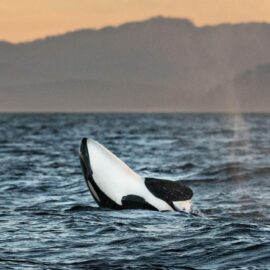
Southern Resident orcas possess a charisma that reaches everyone. Even those who’ve never seen an orca breach the Salish Sea, or watched that black-and-white ripple streak the water, as long as a yacht. Orcas make international headlines—as was the case in 2018, when we watched Tahlequah, another J Pod member, carry her dead calf for 17 days in mourning.
Infant mortality rates among female Southern Residents are now as high as 69 percent. The main reason is the decline of Fraser River spring Chinook, the mainstay of this endangered salmon-hunting species. Experts say there’s still time to save the Fraser’s fish, but it won’t be simple—requiring us to rethink our own role in these complex food webs.
A SPRING CHINOOK ACTION PLAN:
- Remove the Klamath and Snake River dams
- Empower Indigenous knowledge in salmon management practices
- Increase endangered species protections for spring Chinook across their range
- Improve springers’ access to exclusive spawning habitat apart from Fall Chinook
- Promote the use of selective fishing tools like weirs, wheels, pound nets, and dip nets
- Decrease incidental mortality rates in recreational and commercial fisheries
- Reduce competition from hatchery salmon

